COMMENT OF THE DAY: UP FROM THE SHIP CHANNEL “Many will think I’m crazy, but I don’t care . . . Buffalo Bayou (even on the east side of downtown) can be an aesthetically pleasing stream, and could be developed into something nice. Look at the recent improvements and re-naturalization at Eleanor Tinsley park, just a mile upstream. The section between downtown and the Ship Channel (the S.C. technically does not begin until the Turning Basin, about 4 miles east of downtown) is currently mostly idle with vegetated banks and a surprising variety of wildlife. A few more floating litter booms like they use upstream would clean it up a little more, and make for a nice park-like setting.” [Superdave, commenting on Along the Shores of Buffalo Bayou]
Bayous and Waterways
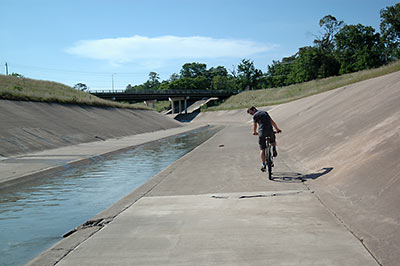
Harris County Housing Authority interim CEO Tom McCasland takes a visitor from Portland along the path of the bike trail he hopes will soon connect Downtown Houston seamlessly to the city’s northwestern suburbs. From Georgia’s Market downtown they head out the MKT Trail into the Heights, which dead ends near the Shepherd-Durham overpasses. “The lot turned into a truck path, which ended at a decrepit railroad bridge. We took a sharp right down a singletrack path along the edge of the bayou far below us,” writes Elly Blue, who’s been touring U.S. cities to assess their bikeability. McCasland, an advocate for expanding Houston bikeways, tells the Houston Press‘s John Nova Lomax that “part of the city’s latest grand biking plan is to dynamite [that burned-out bridge] and rebuild it as a bike/pedestrian thoroughfare. The trail will then continue along White Oak Bayou’s banks and connect with the existing trail that begins at West 11th and TC Jester and heads north through Timbergrove, Garden Oaks, Oak Forest and all the way up to Acres Homes.”
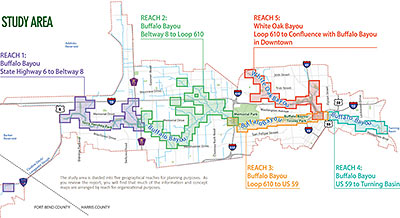
Looks like that Charting Buffalo (as in Buffalo and Lower White Oak Bayous) draft report might not have gone over so well. A popup note shown to first-time visitors to the project’s website, posted just last Friday, dryly notes the entire report has been pulled — only 2 days after it first went out for community feedback: “In light of compelling issues regarding the presentation of certain concepts in the Charting Buffalo draft report, the Harris County Flood Control District is in the process of modifying the report. The District is suspending the report’s distribution, review period and all scheduled community meetings until further notice,” it reads. The feedback period for the report, intended to form the foundation of a master plan for reducing flood damage along the entire Buffalo Bayou and lower White Oak watersheds from the Barker Reservoir to the Ship Channel Turning Basin, was originally scheduled to extend until April 1. Possible flashpoint: the “more than 40 options for reducing flooding risks and damages” spelled out in the report. The Charting Buffalo project was the flood control district’s response to a City of Houston request to “provide land” for stormwater detention.
- Draft Report [Charting Buffalo]
- About the Study [Charting Buffalo]
Map of Study Area: Charting Buffalo
COMMENT OF THE DAY: BEWARE THE ALLURING BAYOU PARK PLAN “This appears to be a banking scheme that would have the Federal Reserve Bank(s) finance and hold securities on these important lands in many large cities across the US. More scrutiny of the fine print and long-term ramifications is needed before yielding to the sensuous propaganda.” [Dana-X, commenting on Enormous Plan To Build Bayou-Side Parks: The Movie]
LOCAL WEBSITE MAKES BOOK  Does li’l ol’ Buffalo Bayou qualify for a river guide? It does now. Longtime bayou history boat tour guide Louis Aulbach — author of 5 river guides chronicling the courses and histories of a few West Texas waterways — has just published Buffalo Bayou: An Echo of Houston’s Wilderness Beginnings as a book. If you’re a bayou or local history buff and that title sounds familiar, it should: Aulbach has been posting extended excerpts from the project on his old-school HAL-PC website for years. [Memorial Examiner; Amazon link]
Does li’l ol’ Buffalo Bayou qualify for a river guide? It does now. Longtime bayou history boat tour guide Louis Aulbach — author of 5 river guides chronicling the courses and histories of a few West Texas waterways — has just published Buffalo Bayou: An Echo of Houston’s Wilderness Beginnings as a book. If you’re a bayou or local history buff and that title sounds familiar, it should: Aulbach has been posting extended excerpts from the project on his old-school HAL-PC website for years. [Memorial Examiner; Amazon link]
COMMENT OF THE DAY: LICKED CLEAN BY MILLIONS OF COCKROACHES “Roaches? I didn’t leave them out. I just didn’t see any — as in, not one. No living creatures at all, except us humans. The place smelled clean, like fresh water. I wonder where those roaches went…. and (ugh) what they were eating down there in the ’80s.” [Lisa Gray, commenting on Comment of the Day: The Cockroaches Found That Cistern First]
NEW BRAUNFELS RESIDENTS APPROVE TUBING CAN BAN 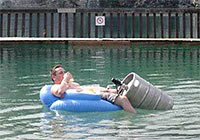 By a wide margin, New Braunfels residents voted to uphold an ordinance passed by city council over the summer that will prohibit Comal and Guadalupe River tubers from using disposable containers within the city limits. Supporters of the beer-can ban, which takes effect January 1, hope it’ll limit pollution from visitors; layers of tossed aluminum cans have been found lining riverbottoms after peak tubing season weekends. A group of local business owners has already filed suit to block the ban, claiming it violates state law. [San Antonio Express-News; previously on Swamplot] Photo: Lelombrik
By a wide margin, New Braunfels residents voted to uphold an ordinance passed by city council over the summer that will prohibit Comal and Guadalupe River tubers from using disposable containers within the city limits. Supporters of the beer-can ban, which takes effect January 1, hope it’ll limit pollution from visitors; layers of tossed aluminum cans have been found lining riverbottoms after peak tubing season weekends. A group of local business owners has already filed suit to block the ban, claiming it violates state law. [San Antonio Express-News; previously on Swamplot] Photo: Lelombrik
MISSOURI CITY GROWS ITS OWN TRAIL MIX 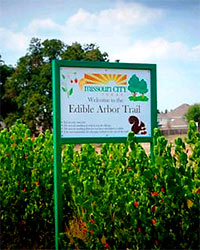 Missouri City forester Paul Wierzbicki tells reporter Cory Stottlemeyer that he expects the Jujubes, Mexican plums, Mexican persimmons, mulberries, pomegranates, figs, pears, and kumquats he began planting along the Oyster Creek Trail last fall to survive through the year. The 70 fruit- and nut-bearing trees now growing along half of the Missouri City section of the trail between Mosley Park and FM 3345 were selected for their tolerance to local conditions, including drought and Gulf Coast pests. Planted in 7 separate groves and interspersed with signage bearing descriptions and the corporate logos of sponsors, they constitute the region’s first-ever edible arbor trail. By next fall, Wierzbicki hopes to have the city’s entire portion of the trail lined with tree bounty trailgoers can reach out and eat. [Fort Bend Sun] Photo: Missouri City
Missouri City forester Paul Wierzbicki tells reporter Cory Stottlemeyer that he expects the Jujubes, Mexican plums, Mexican persimmons, mulberries, pomegranates, figs, pears, and kumquats he began planting along the Oyster Creek Trail last fall to survive through the year. The 70 fruit- and nut-bearing trees now growing along half of the Missouri City section of the trail between Mosley Park and FM 3345 were selected for their tolerance to local conditions, including drought and Gulf Coast pests. Planted in 7 separate groves and interspersed with signage bearing descriptions and the corporate logos of sponsors, they constitute the region’s first-ever edible arbor trail. By next fall, Wierzbicki hopes to have the city’s entire portion of the trail lined with tree bounty trailgoers can reach out and eat. [Fort Bend Sun] Photo: Missouri City
COMMENT OF THE DAY: EACH INGREDIENT IS IMPORTANT “. . . it IS the bayou odor, the bat guano smells, the methane sewer gas & auto exhaust fumes that combine to make the ‘Houston smell’!” [Patrick, commenting on More Pedestrian Bridges and Other Twists and Turns in the Plans for Buffalo Bayou Park]
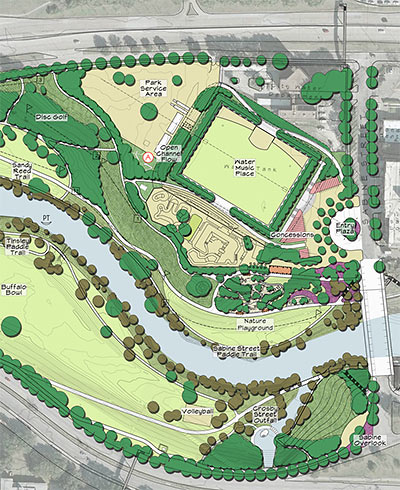
Part of the $50 million plan to turn the banks of Buffalo Bayou west of Downtown from Sabine St. to Shepherd Dr. into a single, continuous linear park: a new entry plaza on Sabine St. at the city waterworks station (near the skatepark, above), a small lake at the end of Dunlavy St., and 3 new pedestrian bridges. One of the bridges is planned for a site just east of Shepherd; another across from the police officer memorial; and the third at Jackson Hill St. Also: lighting, new water features, public art, renovated trails, and a dog park. A separate, $5 million project funded and run by the Harris County Flood Control District will attempt to return the bayou to a more “natural” configuration — by removing sediment and invasive plants and building in bluffs, sandbars, high and low banks, possibly some additional twists and turns, and other more genuinely bayou-ish features. Here’s a plan of the whole thing (turned sideways to fit):
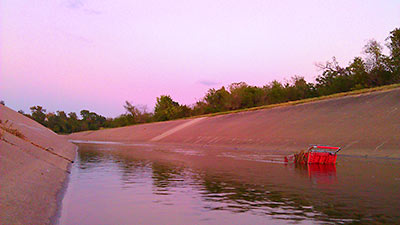
Seen floating past Thelma Dr. in Woodland Heights late yesterday.
- Check out lane on White Oak [Is This Houston?]
Photo: Pankaj
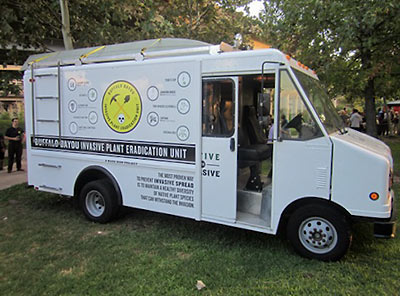
Making its debut last night at the Sabine Promenade downtown: The Buffalo Bayou Invasive Plant Eradication Unit, equipped with gardening tools, microscopes and plant presses, and a taco-truck style ordering counter where you can report or learn about the latest local vegetation battles. The food-truck-style mobile exhibit and lab is the work of New York artist Mark Dion, commissioned by the Houston Arts Alliance and the Buffalo Bayou Partnership. Next stops: the Holly Hall Retirement Community Plant and Bulb Mart at 2000 Holly Hall St. (on Friday) and the Native Plant Symposium at the Omni Hotel at Eldridge Parkway and the Katy Freeway (Saturday). Look for the converted Ford van with the skull and crossed pitchfork and shovel.
- Fighting Invasive Plant Species, One Mobile Artwork at a Time [Art Attack]
- Traveling artwork to be unveiled Wednesday at Sabine Promenade [YourHoustonNews]
- With aliens invading, the Buffalo Bayou Partnership rolls out a plant eradication truck (not a food truck) [Culturemap]
Photo: Meredith Deliso
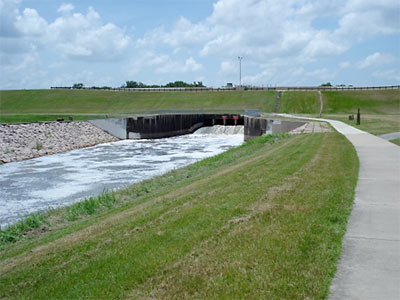
In what appears to be a last-ditch effort to block construction of Segment E, the straight-throught-the-Katy-Prairie section of the Grand Parkway scheduled to begin construction this month, the Sierra Club has filed a new suit against the Army Corps of Engineers, the DOT, the FHA, the Texas Transportation Commission, and several public officials. But the lawsuit also focuses attention on the health of the Addicks and Barker Dams on Buffalo Bayou, which control waterflow through west and Downtown Houston. According to a July 2010 document unearthed by the environmental group this past March through an information request, the Army Corps has rated the status of both dams as “urgent and compelling” since September 2009; that rating indicates the Corps considers them to be 2 of the 6 most dangerous dams in North America.
NEW BRAUNFELS CANS THE BEER CANS As expected, the city council of New Braunfels voted last night to prohibit the use of any type of disposable container within city limits — including the beer cans that regularly pile up underwater on stretches of the Guadalupe and Comal Rivers popular with tubers. The new ordinance is scheduled to go into effect next January: “The ban was approved – on a 5-1 vote – after one protester had been arrested, another had thrown a volleyball-sized wad of dollar bills at the council, a lawsuit had been promised, and citizens had paraded to the podium for an hour to express their support or opposition.” [Herald-Zeitung; previously on Swamplot] Video of Comal River bottom after Memorial Day: Texas Bottle Bill
TUBING IN NEW BRAUNFELS WITHOUT THE CANS  The New Braunfels city council is scheduled to vote this evening on an ordinance that would change the face of Guadalupe and Comal River tubing as we know it, by banning all disposable containers on those popular waterways within city limits. The same body already voted 5-2 in favor of the beer-can ban earlier this month. The vote has been moved from city hall to the city convention center to accommodate expected crowds. “[Don’s & Ben’s liquor store assistant manager Brendon] Keith and other retailers are scratching their heads over what devices tubers might employ — the proposed ordinance doesn’t specify. A Thermos or canteen wouldn’t keep carbonated beverages fresh on an hours-long float, and you’d have to have a nondisposable cup . . . Another potential problem is that any beverage delivery device that’s not sealed would be, strictly speaking, a violation of the state open container law.” [Statesman] Photo: Lelombrik
The New Braunfels city council is scheduled to vote this evening on an ordinance that would change the face of Guadalupe and Comal River tubing as we know it, by banning all disposable containers on those popular waterways within city limits. The same body already voted 5-2 in favor of the beer-can ban earlier this month. The vote has been moved from city hall to the city convention center to accommodate expected crowds. “[Don’s & Ben’s liquor store assistant manager Brendon] Keith and other retailers are scratching their heads over what devices tubers might employ — the proposed ordinance doesn’t specify. A Thermos or canteen wouldn’t keep carbonated beverages fresh on an hours-long float, and you’d have to have a nondisposable cup . . . Another potential problem is that any beverage delivery device that’s not sealed would be, strictly speaking, a violation of the state open container law.” [Statesman] Photo: Lelombrik

